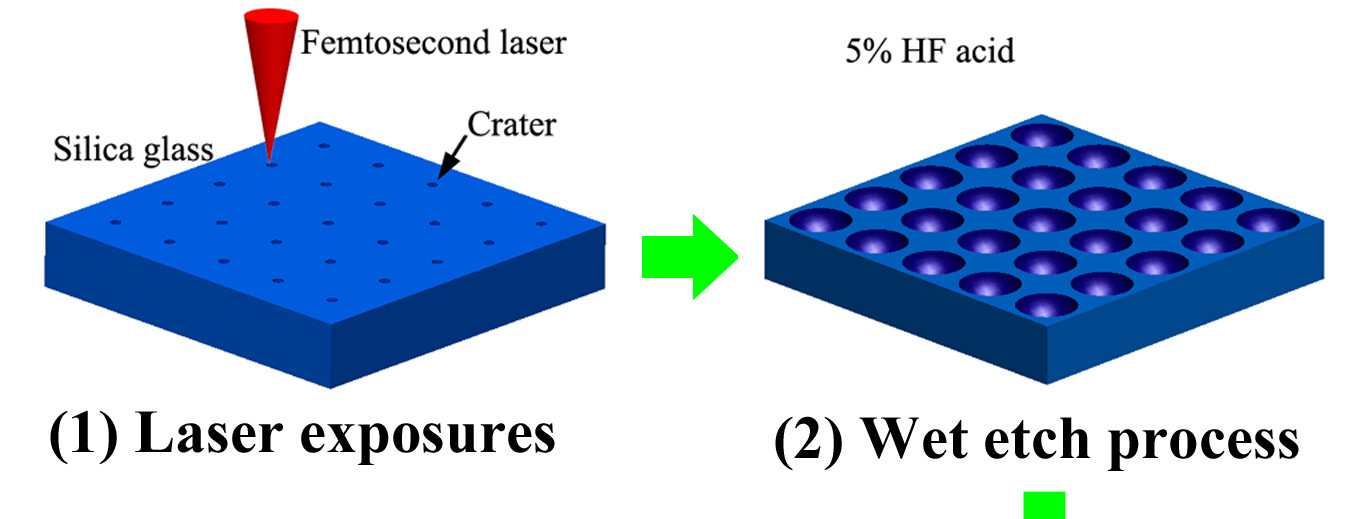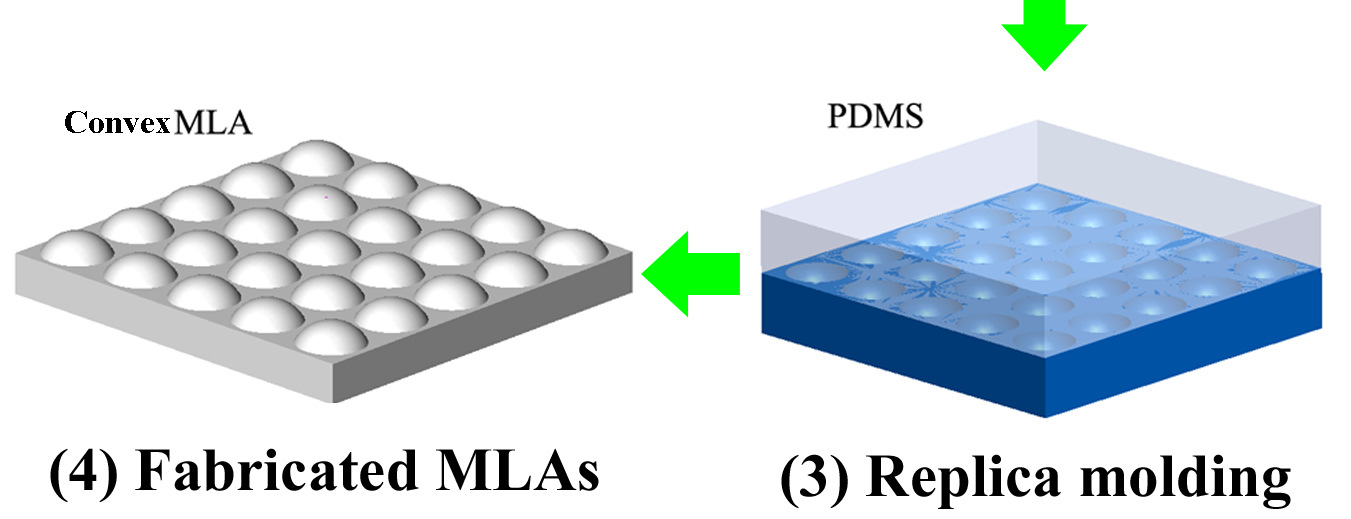Abstract: This work reveals a cost-efficient and flexible approach to various microlens arrays on polymers, which is essential to micro-optics elements. An 800-nm femtosecond laser is employed to control the hydrofluoric (HF) acid etching process on silica glasses, and concave microstructures with smooth curved surfaces are produced by this method. Then, the micro-structured glass templates can serve as molds for replicating microlenses on polymers. In this paper, a high-ordered microlens array with over 16,000 hexagonal-shaped lenses is fabricated on poly (dimethyl siloxane) [PDMS], and its perfect light-gathering ability and imaging performance are demonstrated. The flexibility of this method is demonstrated by successful preparation of several concave molds with different patterns which are difficult to be obtained by other methods. This technique provides a new route to small-scaled, smooth and curved surfaces which is widely used in micro-optics, biochemical analysis and superhydrophobic interface.
Due to their low-cost, comparable transparency and ease of preparation, polymers are widely used to fabricate micro-optics elements such as two-dimensional (2D) refractive microlens arrays (MLAs). Combined with other functional devices, polymer MLAs play a key role in optical communications, high-definition display, biomedical systems and so on. In the past decades, a variety of strategies have been adopted for manufacturing MLAs. In general, the majority of fabrication process for polymer MLAs, including photoresist reflow method , gray-scale photolithography , LIGA process (German acronym for lithography, electroforming, and molding) , and so on, requires masks for photolithography, expensive equipments, and complex and elaborate processing. Moreover, it is difficult to obtain desired profiles of the microlenses. Some maskless approaches such as ink-jet process and selfassembled particle monolayers demonstrate the ability to produce semi-spherical polymeric microlenses , but the sophisticated processes are needed to precisely control the alignment of each lens.
In recent years, femtosecond (fs) laser direct writing process has become a popular tool to fabricate arbitrary three-dimensional (3D) microstructures with nanometer accuracies. Femtosecond-laser-induced two-photon polymerization (TPP) allows for the formation of microlenses or more complex 3D microstructures in polymers. However, this point-bypoint process suffers from the limitation of low efficiency. Recently, H. Sun and associates have proposed an improved TPP process by the usage of the negative tone resin SU-8. Only the surface layer of microstructures, or nanoshells, was photopolymerized by direct laser writing, and the inner portion was solidified by ultra-violet lights. The fabrication efficiency was increased significantly. For example, it needed only 6 minutes to fabricate a microlens structure with a diameter of 80 µm , which typically cost several tens of minutes for the previous TPP technique. Despite this, it is still not suitable for fabrication of large-area MLAs with over thousands of lenses.


Fig1
The fabrication procedures of the polymeric MLAs are schematically depicted in Fig. 1, which comprise of two steps of producing molding templates with concave microstructures and replicating the convex microlenses on polymers. To fabricate molding templates, an fs laser beam, which is created by a Ti: sapphire pulsed laser oscillator-amplifier system (wavelength = 800 nm; pulse duration = 30 fs; repetition rate = 1 kHz), is focused onto the surface of a polished silica glass chip by a microscope objective lens (NA = 0.5, Nikon). The laser exposure spots are generated point-by-point. For each spot, the exposure time is controlled by a fast mechanical shutter and the laser power is tuned by a variable attenuator. The optical setup has been reported in other literatures [12]. After the laser exposures, the sample is immersed in 5% hydrofluoric (HF) acid solution (diluted by deionized water) at room temperature. To guarantee the uniformity of the microstructures, an ultrasonic bath is used to remove the bubbles generated at liquid-solid interface during the chemical etching process. The fabrication process can be monitored by an optical microscope equipped with a CCD camera. When the smooth concave surfaces are successfully fabricated, the sample is cleaned by deionized water and dried.
The convex MLAs are replicated on poly (dimethyl siloxane) [PDMS] by the fabricated mold. The liquid PDMS is prepared by mixing Dow Corning Sylgard 184 with catalyst (10:1 ratio) and degassing in vacuum for 30 minutes. The mixture is then poured onto the mold and cured at 70°C for 100 minutes.